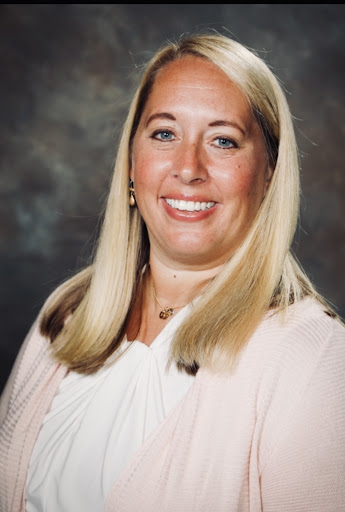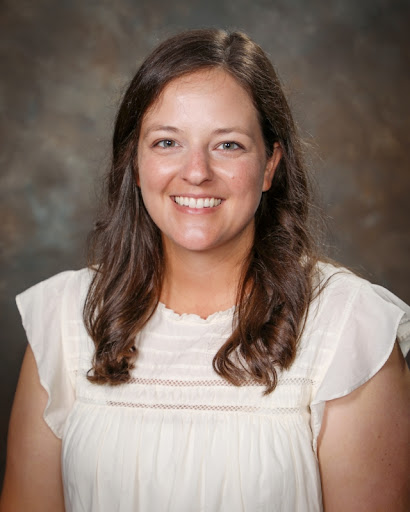Brookstone School is an independent school in Columbus, Georgia, serving 800 students in 3K–12th grade. In this spotlight, Joseph Mills, Director of Preschool, Professional Learning, and Curriculum, Lower & Intermediate Schools, and second grade teachers April Sullivan and Emily Allardice discuss how Collaborative Classroom’s comprehensive ELA program Collaborative Literacy supports Brookstone School teachers and increases student engagement.
Joseph Mills, Director of Preschool, Professional Learning, and Curriculum, Lower & Intermediate Schools

Tell us a little about yourself, Brookstone, and the students that you serve.
At Brookstone School, we strive for classrooms that represent a diversity of experience, culture, and ability. Most of our teachers have been teaching reading and writing in the workshop model for six or seven years. The second grade teachers, Emily Allardice, Caroline Kennon, and April Sullivan, bring a variety of experiences in teaching with expertise in early childhood education.
Your Collaborative Literacy implementation began with adopting Collaborative Classroom’s writing curriculum, Being a Writer, and then grew over time with the addition of our reading programs. Tell us a little about your implementation.
We began implementing Being a Writer several years ago across grades K–5. Transitioning from Units of Study in Writing, we found that Being a Writer provided more support for our emergent and developing writers and for the teachers.
Then the second grade team added Collaborative Classroom’s Making Meaning program two years ago, and began a pilot of Being A Reader this past year.
What do you appreciate about Collaborative Literacy?
We love the interwoven support for social skills development. Our students are developing stronger conversation skills and deepening their thinking and understanding through collaboration with their peers and teachers.
We also appreciate the professional learning supports incorporated in the Collaborative Literacy materials, particularly the facilitation tips, and the assessment resources.
What have you noticed about your students’ learning and engagement?
Our students are highly engaged in discussions about the read-aloud and mentor texts used in lessons! The thinking strategies taught in Collaborative Literacy have led them to deeper thinking about and beyond the text.
As writers, our students are confident and enthusiastic. This past year we focused on better integrating grammar and mechanics in each unit, and we saw students incorporating more of the skills in their independent writing. They love writing and are always eager to share their work with their peers.
How has Collaborative Literacy affected or changed your own teaching and learning?
I appreciate Collaborative Classroom’s implementation support for literacy coaches and administrators. The guides have helped me be more intentional in planning sessions, be more focused in analyzing student data, and be more specific in giving feedback.
I appreciate Collaborative Classroom’s implementation support for literacy coaches and administrators.
The facilitation techniques the teachers learn and use with students in the program have also helped me be a better facilitator of professional learning!
What advice or insights would you share with an educator who is new to Collaborative Literacy?
Don’t overlook the front matter in the teacher manuals! There is a wealth of information there about the structure and components of the program. In the beginning, we mainly focused on the meat of the lessons. As teachers became more familiar with the structure and flow of the lessons, we were able to pay more attention to the support materials such as class and individual assessments, the side notes, etc.
April Sullivan, Second Grade Teacher, Brookstone School

Tell us about yourself and your teaching experiences at Brookstone School.
My name is April Sullivan. I have been teaching at Brookstone School for four years, getting ready to start my fifth in August. I was a first grade assistant for the first three years so I could observe the classroom, and get to know the curriculum. I went back full time last year as a second grade teacher, and I absolutely love it!
As a classroom teacher, what do you appreciate about Collaborative Literacy?
This was my first year back full time as a lead, and our second grade team piloted Being a Reader [the reading component of Collaborative Literacy]. We used the teacher’s manual daily, along with implementing the word study, vocabulary, and small-group reading.
We made a point to follow it exactly as it was outlined, even on days when it initially felt like the order didn’t make sense. I am glad we did, because it lined up perfectly every time!
The program is planned out so well for the teacher; it gives such a great guide for you as you are teaching, but also allows you to make it your own.
The program is planned out so well for the teacher; it gives such a great guide for you as you are teaching, but also allows you to make it your own. It gives each student the opportunity to be involved in so many areas as well.
The material is also exciting for the children, with a lot of variety, so I never felt like I struggled to keep the students engaged.
What have you noticed about your students’ learning and engagement?
As I said before, due to the variety and also to the fact that so much of the material goes hand-in-hand, the students were always engaged. They also had a lot of “ah ha” moments when recalling information, so they enjoyed giving input and sharing their ideas. They loved collaborating with one another, because it allowed them to be heard, and feel confident in their thinking.
[Students] loved collaborating with one another, because it allowed them to be heard, and feel confident in their thinking.
Small-group reading was such a highlight for my class, and I love the way that no one knew they were in groups based on reading level, rather just thinking it was at random. Students who were typically reserved came out of their shells during this time as well. I absolutely loved this time with small groups.
How has Collaborative Literacy affected or changed your own teaching and learning?
It has really taught me that you don’t have to be fixed on one specific way of teaching. It’s ok to be flexible, and if you are working with students who are really engaged in a lesson, it’s fine to push “time” to the side to stay planted in one area so the students are benefiting.
Students are asked to do a lot of questioning and wondering in the program. This has been such a great learning experience for me, because regardless of what I may think about a lesson, sometimes children see it in a totally different light—and from that I continue to learn.
What advice or insights would you share with an educator who is new to Collaborative Literacy?
In the beginning, this program can seem overwhelming, because it seems like there are so many moving parts. Once you get into a rhythm, you realize the program is planned out perfectly and helps simplify your teaching structure, so you can collaborate more with your students, and your students can collaborate with one another.
Once you get into a rhythm, you realize the program is planned out perfectly and helps simplify your teaching structure, so you can collaborate more with your students, and your students can collaborate with one another.
It’s just like getting to know your students in the first couple of weeks: once you know how your students operate, it’s easier to work with them. Once you understand the alignment of this curriculum, it takes a load off for you so you can be expressive in your teaching.
Emily Allardice, Second Grade Teacher

Tell us a little about yourself and your role at Brookstone School.
I have been fortunate to begin my career at Brookstone and just finished my 6th year here. I have spent all of those years in second grade, first as a full day assistant for a year and now as a classroom teacher.
As a long-time Brookstone School teacher, tell us about your experiences implementing Collaborative Literacy.
My first experience with Collaborative Literacy was Being a Writer. We began using this program three years ago during “the COVID year” when we spent the spring learning virtually.
Although Being a Writer was a new program to us, the second grade teachers felt that our students were able to handle the transition to virtual learning more seamlessly because of the collaborative structures that were used throughout the year.
Since then, we have used Caring School Community, Making Meaning, and most recently Being a Reader for second grade. We piloted grade 2 of Being a Reader during the 2021–22 school year, and it was a bit daunting when the many boxes arrived at school. However, we had a professional learning session during pre-planning to help us with implementation. This session was incredibly helpful because we learned where to focus and where to start.
After that, we dove into the first unit and the teacher’s manuals were very easy to follow. There is so much reasoning intentionally included in the teacher’s manuals that we felt confident following the program this first year.
The manuals are also designed in a very predictable way which allows teachers to spend time digging into the content rather than searching for the important teaching points.
We also were supported with professional learning sessions throughout the year. I think these sessions, along with the thoughtfully designed program, have helped us feel very confident with the content even in our first year of implementation. There are only a few things we learned that we would like to change for next year!
What do you appreciate about Collaborative Literacy?
I appreciate the thoughtfulness of the programs, including the teacher’s manuals, student resources, and online resources. Each unit also has built-in extensions—many that have resources provided—so students are able to easily (and safely) explore more about a topic if they would like.
I appreciate the thoughtfulness of the programs, including the teacher’s manuals, student resources, and online resources.
I also appreciate the carefully chosen mentor texts. They are interesting, engaging, diverse, and always keep the children wanting more.
What have you noticed about your students’ learning and engagement?
My students are incredibly excited when we explore a new mentor text in both reading and writing. They also enjoy having the freedom to talk to their partner so often and let their thoughts be heard. That is often one of the most challenging parts of completing a lesson for me because the students have so much they want to say!
My students also LOVED doing small-group reading (in Being a Reader) this year. We saw incredible reading growth this year and had so much fun with the books. Although the structure of the small-group routines is consistent and predictable for the students, there were also fun reader’s theater performances they were able to do for their classmates to show off.
We saw incredible reading growth this year and had so much fun with the books.
My students enjoyed the books so much that they complained when it was time to stop reading our mentor texts or their small-group books.
How has Collaborative Literacy affected or changed your own teaching and learning?
I think I am very fortunate to be exposed to the collaborative structures so early in my teaching career. These expectations are completely different from what I was exposed to during my teacher training program and student teaching.
Collaborative Literacy provides the framework for clear and consistent collaboration within the classroom. Using this framework has helped me have high expectations for my students and the responsibility that they develop for their learning.
What advice or insights would you share with an educator who is new to Collaborative Literacy?
It can seem overwhelming at first, especially if you are not used to students working collaboratively throughout the day, but it gets easier throughout the year. Your evidence of student learning comes from conferring with them and hearing about what they are thinking about their reading or what their plans are for their writing piece. There will not be worksheets to grade and put into the gradebook.
Following the manuals closely the first year is very helpful—don’t try to take things out or skip around too much because all of the lessons are designed to build on one another.
Familiarize yourself with the online resources. There are so many helpful guides, handouts, parent communications, data trackers, etc. You won’t have to create your own!
Finally, enjoy the deep conversations that you will have with your students!
***
Read another independent school spotlight: The Bolles School, Florida.
Learn more about Collaborative Literacy and its component programs, Being a Writer and Being a Reader.
